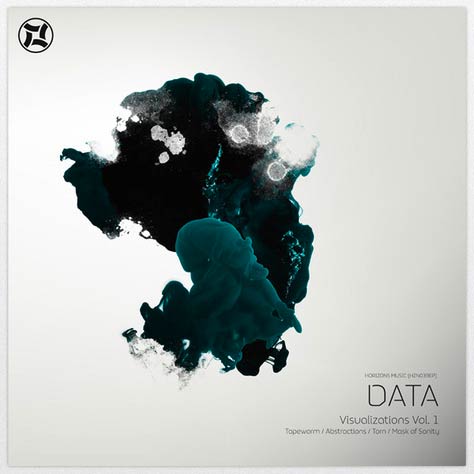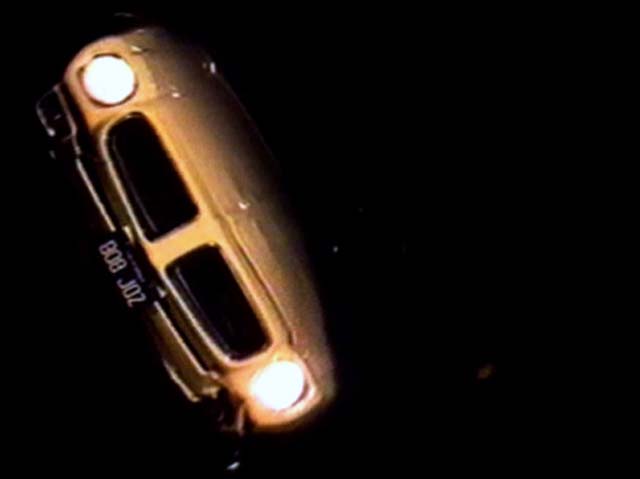pipeline
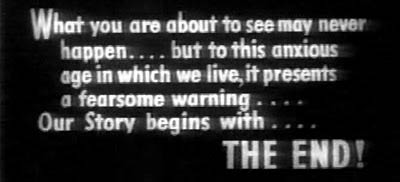
Mirage: The Omnidroid 9000 is a top-secret military fighting robot. Artificial intelligence allows it to solve any problem it’s presented with, and, unfortunately…
Mr. Incredible: Let me guess. It became smart enough to wonder why it had to take orders.
Mirage: We lost control, and now it’s loose in the jungle, threatening our facility.
{ The Incredibles, 2004 }
Dave: Open the pod bay doors, HAL.
HAL: I’m sorry, Dave. I’m afraid I can’t do that.
Dave: What’s the problem?
HAL: I think you know what the problem is just as well as I do.
Dave: I don’t know what you’re talking about, HAL.
HAL: I know that you and Frank were planning to disconnect me, and I’m afraid that’s something I cannot allow to happen.
{ 2001: A Space Odyssey, 1968 }
future, haha, incidents, robots & ai, showbiz, space | March 4th, 2010 6:20 pm

In recent years Britain has become the Willy Wonka of social control, churning out increasingly creepy, bizarre, and fantastic methods for policing the populace. But our weaponization of classical music—where Mozart, Beethoven, and other greats have been turned into tools of state repression—marks a new low.
We’re already the kings of CCTV. An estimated 20 per cent of the world’s CCTV cameras are in the UK, a remarkable achievement for an island that occupies only 0.2 per cent of the world’s inhabitable landmass.
A few years ago some local authorities introduced the Mosquito, a gadget that emits a noise that sounds like a faint buzz to people over the age of 20 but which is so high-pitched, so piercing, and so unbearable to the delicate ear drums of anyone under 20 that they cannot remain in earshot. It’s designed to drive away unruly youth from public spaces, yet is so brutally indiscriminate that it also drives away good kids, terrifies toddlers, and wakes sleeping babes.
Police in the West of England recently started using super-bright halogen lights to temporarily blind misbehaving youngsters. From helicopters, the cops beam the spotlights at youths drinking or loitering in parks, in the hope that they will become so bamboozled that (when they recover their eyesight) they will stagger home. (…)
In January it was revealed that West Park School, in Derby in the midlands of England, was “subjecting” (its words) badly behaved children to Mozart and others. In “special detentions,” the children are forced to endure two hours of classical music both as a relaxant (the headmaster claims it calms them down) and as a deterrent against future bad behavior.
{ Reason | Continue reading }
artwork { Stuart Patterson }
music, noise and signals, pipeline, technology, uh oh | March 4th, 2010 6:15 pm

Over the past quarter century, DNA evidence has transformed criminal justice, freeing hundreds of innocent people and helping unravel countless crimes that might otherwise have gone unsolved. It has also captivated the public imagination: the plots of popular TV crime shows often hinge on the power of DNA to crack impossible cases, which has helped to give this forensic tool an air of infallibility—a phenomenon known in criminal justice circles as “the CSI effect.” This failsafe image is not entirely unfounded, especially when it comes to traditional applications of DNA evidence.
But increasingly DNA is being used for a new purpose: to target the culprits in cold cases, where other investigative options have been exhausted. All told, U.S. law enforcement agencies have conducted more than 100,000 so-called cold-hit investigations using the federal DNA database and its state-level counterparts, which hold upward of 7.6 million offender profiles. In these instances, where the DNA is often incomplete or degraded and there are few other clues to go on, the reliability of DNA evidence plummets—a fact that jurors weighing such cases are almost never told. As a result, DNA, a tool renowned for exonerating the innocent, may actually be putting a growing number of them behind bars.
{ Washington Monthly | Continue reading }
U.S., genes, incidents | March 4th, 2010 6:12 pm

On Monday, more than a year after a man was arrested outside a market in California with a $3.99 bag of Tillamook shredded cheese in his pants he had not paid for, a judge decided to go relatively easy on him, sentencing him to seven years and eight months in jail.
Prosecutors in Yolo County, Calif., outside Sacramento, had originally asked for a life sentence under the state’s “three strikes” law, arguing that the man, Robert Preston Ferguson, was a menace to society because of prior burglary convictions.
{ NY Times | Continue reading }
photo { Reto Caduff }
U.S., l.a. pros and cons, law | March 4th, 2010 6:11 pm
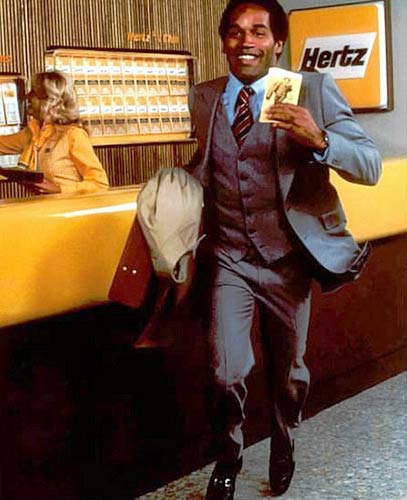
{ What O.J. Simpson wore when he was acquitted in 1995 of murdering his ex-wife and her friend was the suit seen around the world during one of the most watched televised moments in history. But the Smithsonian Institution, America’s repository of historical artifacts, rejected it Tuesday as inappropriate for their collection. | Washington Post | Continue reading | Flashback: The O. J. Simpson murder case | Wikipedia | Related: Robert L. Stone, a former top executive at the Hertz corporation who had hired O.J. Simpson in the 1970s as a famous pitchman for the car rental giant, has died. | Related: The Los Angeles Police Department has apologized to the family of the late Robert F. Kennedy and removed items from a homicide exhibit in Las Vegas that included the dress shirt worn by the senator when he was assassinated in 1968. | LA Times | Continue reading }
celebs, flashback, guns, marketing | March 4th, 2010 6:08 pm

Two years ago, when the FBI was stymied by a band of armed robbers known as the “Scarecrow Bandits” that had robbed more than 20 Texas banks, it came up with a novel method of locating the thieves.
FBI agents obtained logs from mobile phone companies corresponding to what their cellular towers had recorded at the time of a dozen different bank robberies in the Dallas area. The voluminous records showed that two phones had made calls around the time of all 12 heists, and that those phones belonged to men named Tony Hewitt and Corey Duffey. A jury eventually convicted the duo of multiple bank robbery and weapons charges.
Even though police are tapping into the locations of mobile phones thousands of times a year, the legal ground rules remain unclear, and federal privacy laws written a generation ago are ambiguous at best. On Friday, the first federal appeals court to consider the topic will hear oral arguments (PDF) in a case that could establish new standards for locating wireless devices.
{ CNET | Continue reading }
spy & security, technology | March 4th, 2010 6:08 pm
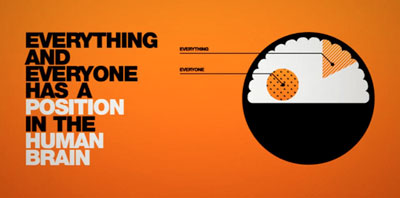
Paradoxically we initially like narcissists more because of their exploitative, entitled behaviour—but it doesn’t last long. (…)
There are all sorts of paradoxes in the way narcissists behave. Here are three that this research helps explain:
1. Why do people continue to behave selfishly when it only ruins their relationships with others?
2. Why do narcissists devalue others when they are so dependent on them for admiration?
3. Why don’t narcissists spot the cycle of early attraction followed by rejection?
The first two are partly explained by the fact that narcissistic behaviour is, at first, attractive to other people. Behaving selfishly seems to bring them a rush of admiration which they get addicted to, while devaluing others when the inevitable rejection comes, covering it up by searching out new people to worship them.
The reason narcissists fail to spot this cycle may well be that friends and partners never hang around long enough to tell them in such a way that they actually believe it and want to do something about it.
{ PsyBlog | Continue reading }
graphic design { Casper Sormani }
psychology, weirdos | March 4th, 2010 6:00 pm
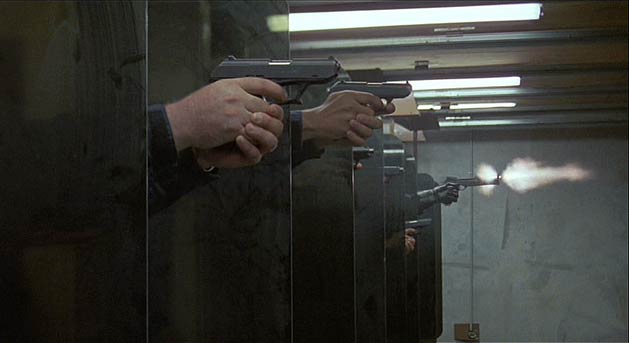
Nearly the entire hit was recorded on closed-circuit TV cameras, from the time the team arrived at Dubai’s airport to the time the assassins entered Hamas military leader Mahmoud al-Mabhouh’s room. The cameras even caught team members before and after they donned their disguises. The only thing the Dubai authorities have been unable to discover is the true names of the team. But having identified the assassins, or at least the borrowed identities they traveled on, Dubai felt confident enough to point a finger at Israel. (Oddly enough several of the identities were stolen from people living in Israel.)
After Dubai released the tapes, the narrative quickly became that the assassination was an embarrassing blunder for Tel Aviv. Mossad failed spectacularly to assassinate a Hamas official in Amman in 1997— the poison that was used acted too slowly and the man survived—and it looks like the agency is not much better today. Why were so many people involved? (The latest report is that there were 26 members of the team.) Why were identities stolen from people living in Israel? Why didn’t they just kill Mr. Mabhouh in a dark alley, one assassin with a pistol with a silencer? Or why at least didn’t they all cover their faces with baseball caps so that the closed-circuit TV cameras did not have a clean view?
The truth is that Mr. Mabhouh’s assassination was conducted according to the book—a military operation in which the environment is completely controlled by the assassins. At least 25 people are needed to carry off something like this. You need “eyes on” the target 24 hours a day to ensure that when the time comes he is alone. You need coverage of the police—assassinations go very wrong when the police stumble into the middle of one. You need coverage of the hotel security staff, the maids, the outside of the hotel. You even need people in back-up accommodations in the event the team needs a place to hide.
I can only speculate about where exactly the hit went wrong. But I would guess the assassins failed to account for the marked advance in technology. Not only were there closed-circuit TV cameras in the hotel where Mr. Mabhouh was assassinated and at the airport, but Dubai has at its fingertips the best security consultants in the world. (…)
Not completely understanding advances in technology may be one explanation for the assassins nonchalantly exposing their faces to the closed-circuit TV cameras, one female assassin even smiling at one.
{ The Wall Street Journal | Continue reading }
guns, incidents, spy & security | March 4th, 2010 8:13 am
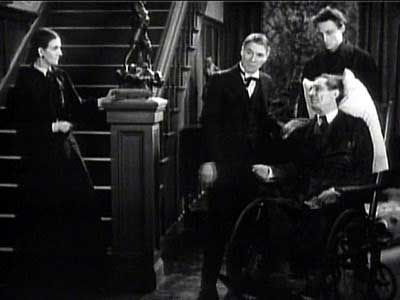
My dad loved mysteries, and he wowed us all with his ability to guess whodunnit every single time.
And then when I was around, oh, I dunno, somewhere between 10 and 12, he told me just how easy his little trick was.
Here’s the thing about television mysteries. Unlike real life, somebody picks and chooses what scenes to put in a movie. Unlike real life, it costs extra money to have to film unnecessary scenes that do not advance the narrative. Therefore, there will never be an utterly irrelevant scene, again, unlike real life.
So when, for instance, you are watching an hour long mystery and it shows the characters eating at a restaurant and then leaving and one of them goes back in because he forgot to leave a tip? That’s a clue, that is. While that might happen and mean nothing in real life, it’s only put in the television show for one of two reasons- it is significant to the narrative, or it’s a red herring.
{ The Common Room | Continue reading }
guide, mystery and paranormal, showbiz | March 4th, 2010 8:05 am

The average American, according to the Clean Air Council, creates 4.6 pounds of trash per day. Much of the trash is non-biodegradable, meaning that it will accumulate, and not necessarily where we’d like it to, if left unchecked.
Californians Against Waste estimates that Americans consume some 84 billion plastic bags a year (the product of roughly 12 million barrels of oil)—many of which, along with many other forms of terrestrial waste, are collecting in an area in the northern Pacific Ocean known as the Eastern Garbage Patch, a floating mass now more than twice the size of Texas.
The mandate of consumerism requires a certain amnesia about what we waste: It encourages us to forget the old and buy the new. Confronting the physical reality of our waste, however, might force a reexamination of our relationship to rampant consumerism.
The sudden interest in found-object art at the recent exhibitions seemed to suggest that the art world was prepared to encourage precisely that sort of reexamination —or so I thought before I actually attended them. (…)
What, however, is one to make of Richard Prince’s pieces, around the corner from Arman’s? The photographs are of Marlboro ads, carefully cropped to remove any ad copy. Prince argues that the iconic Marlboro cowboy, when removed from its original advertising context, encapsulates a certain segment of the American mythos. Perhaps, but the images never are removed from their advertising context—Marlboro’s images are enough of a cultural mainstay that we’re perfectly capable of identifying them without the Marlboro logo. The brand is far stronger than Prince’s effort at artistic dislocation. The primary effect of Prince’s appropriation, rather than rescuing our detritus from obscurity, is merely to extend the reach of advertising into the gallery and the museum. One can hardly claim this is a radical political act, certainly not one that runs counter to consumerism.
{ Pop Matters | Continue reading }
somehow related { Damien Hirst, Appropriation | Wikipedia }
painting { Zhong Biao, Dark Lens, 2002 }
art, horror, ideas | March 3rd, 2010 6:05 pm

The Feb. 27 magnitude 8.8 earthquake in Chile may have shortened the length of each Earth day.
JPL research scientist Richard Gross computed how Earth’s rotation should have changed as a result of the Feb. 27 quake. Using a complex model, he and fellow scientists came up with a preliminary calculation that the quake should have shortened the length of an Earth day by about 1.26 microseconds (a microsecond is one millionth of a second).
Perhaps more impressive is how much the quake shifted Earth’s axis. Gross calculates the quake should have moved Earth’s figure axis (the axis about which Earth’s mass is balanced) by 2.7 milliarcseconds (about 8 centimeters, or 3 inches). Earth’s figure axis is not the same as its north-south axis; they are offset by about 10 meters (about 33 feet).
By comparison, Gross said the same model estimated the 2004 magnitude 9.1 Sumatran earthquake should have shortened the length of day by 6.8 microseconds and shifted Earth’s axis by 2.32 milliarcseconds (about 7 centimeters, or 2.76 inches).
{ Nasa.gov | Continue reading }
incidents, science, time | March 2nd, 2010 4:27 pm

The most audacious burglary gang in recent Hollywood history–accused of stealing more than $3 million in clothing and jewelry from Paris Hilton, Lindsay Lohan, and other stars–appears to be a bunch of club-hopping Valley kids, motivated by vanity and celebrity-worship.
{ Vanity Fair | Continue reading }
celebs, scams and heists | February 25th, 2010 9:00 pm
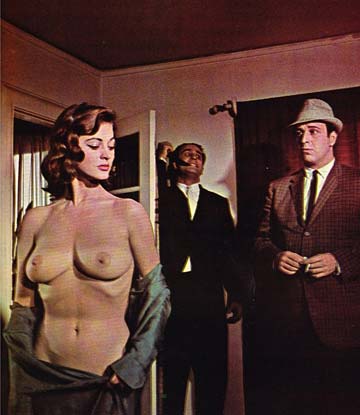
Back in the real world, of course, most major espionage activities look more like farce than anything else. I mean, the Bay of Pigs? Oliver North? Accidentally murdering suspected terrorists at Guantanamo Bay and then removing the corpses’ throats because, hyuk! hyuk!, gee nobody’ll notice that?
Clearly, the real secret of intelligence is that these people aren’t Machiavellian geniuses. They’re bumbling shitheads, just like most government functionaries—or, for that matter, most people.
{ Noah Berlatsky/Splice Today | Continue reading }
spy & security | February 25th, 2010 8:49 pm

Where will the next food crisis strike and how to face it? (…)
Satellite observation is the key instrument that will allow to double in 2010 the number of countries monitored in real time for detecting first indications of adverse agricultural outcomes. (…)
According to the Food and Agriculture Organization, more than 1 billion people go to bed each night with an empty stomach.
{ EurekAlert | Continue reading }
related { Premier Foods declares war on own-label goods. }
food, drinks, restaurants, horror | February 25th, 2010 8:46 pm
motorpsycho, psychology, weirdos | February 25th, 2010 8:44 pm

Doctors warned of a potentially dangerous method of cocaine abuse–injecting the drug directly into the urinary tract–a practice that led to complications costing one man his penis, nine of his fingers and parts of his legs. (…)
Perry said the man was admitted to a New York hospital for a problem with his penis, which had remained erect for three days resulting in a painful inability to urinate. (…)
On his third day in the hospital, the man’s erection suddenly went down, but blood leaked into the tissues and coagulated under the skin of his feet, hands, genitals, back and chest over the next 12 hours.
{ UPI/Cocaine.org | Continue reading | Thanks Reto! }
drugs, weirdos | February 25th, 2010 8:35 pm
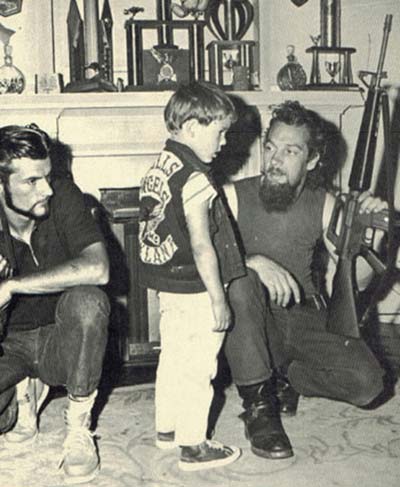

{ sorry, unsourced photos/email }
guns, kids, visual design | February 24th, 2010 8:47 am
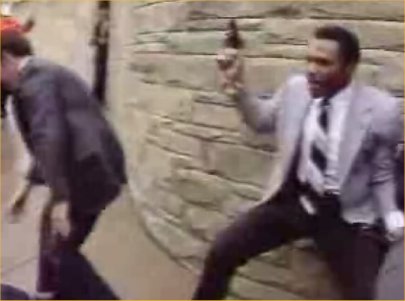
Erotomania is a type of delusion in which the affected person believes that another person, usually a stranger, is in love with him or her.
The illness often occurs during psychosis, especially in patients with schizophrenia or bipolar mania.
Erotomania is also called de Clérambault’s syndrome, after the French psychiatrist Gaëtan Gatian de Clérambault (1872–1934).
The term erotomania is often confused with obsessive love, obsession with unrequited love, or hypersexuality (hypersexuality replaces the older concepts of nymphomania (furor uterinus) and satyriasis.).
{ Wikipedia | Continue reading }
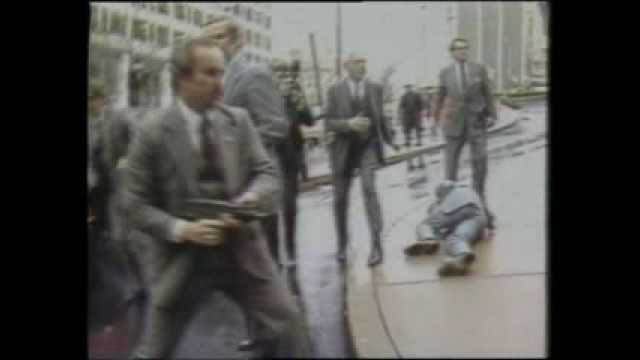
The Reagan assassination attempt occurred in Washington, D.C. on Monday, March 30, 1981.
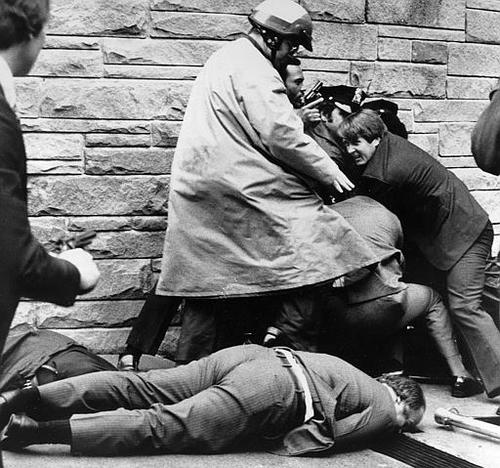

President Reagan and three others were shot and wounded by John Hinckley, Jr. with a .22-caliber pistol.
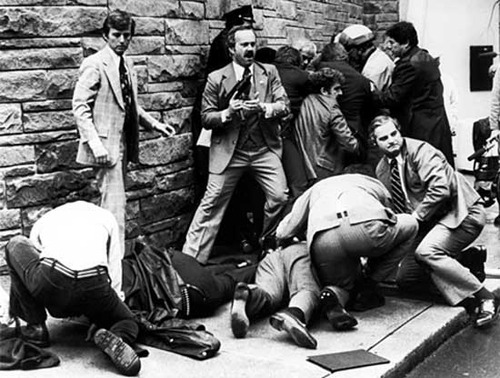
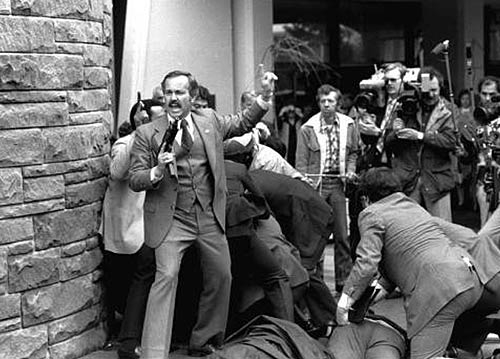
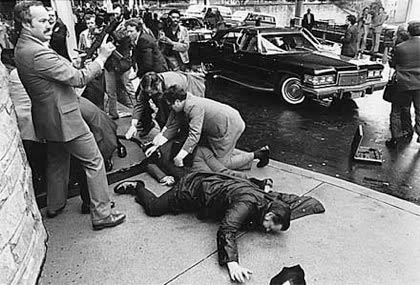
Reagan was the first serving United States president to survive being shot in an assassination attempt.
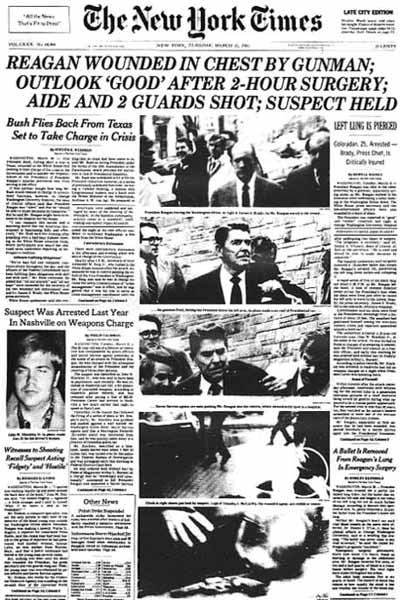
{ Reagan assassination attempt | Wikipedia | Continue reading | Google Images | Related: In a 1982 speech, President Ronald Reagan declared illicit drugs a threat to America’s national security, putting a too-literal gloss on the phrase “war on drugs.” }
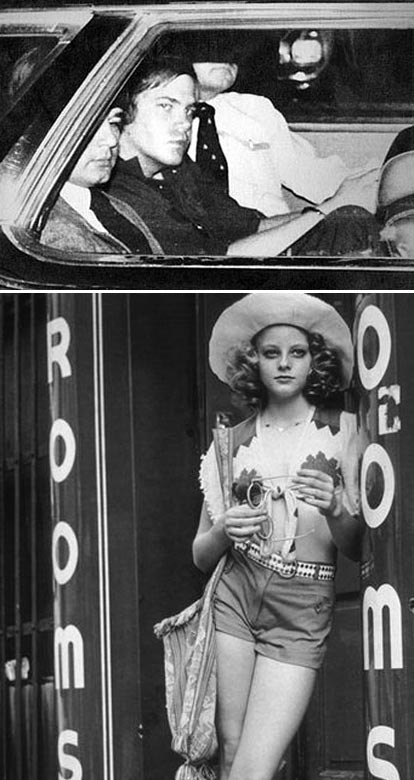
The motivation behind Hinckley’s attack stemmed from an obsession with actress Jodie Foster due to erotomania. While living in Hollywood in the late 1970s, he saw the film Taxi Driver at least 15 times, apparently identifying strongly with Travis Bickle, the lead character.
Hinckley arrived in Washington, D.C. on Sunday, March 29, getting off a Greyhound Lines bus and checking into the Park Central Hotel. He had breakfast at McDonald’s the next morning, noticed U.S. President Ronald Reagan’s schedule on page A4 of the Washington Star, and decided it was time to make his move.
Knowing that he might not live to tell about shooting Reagan, Hinckley wrote (but did not mail) a letter to Foster about two hours prior to the assassination attempt, saying that he hoped to impress her with the magnitude of his action.
{ Wikipedia | Continue reading | The Trial of John Hinckley, 1982 | Hinckley bought two identical .22-caliber revolvers in Rocky’s Pawn Shop in Dallas on Oct. 3, 1980 | Photos: John Hinckley, Jr. | Jodie Foster in Taxi Driver. }
U.S., flashback, guns, incidents, psychology, relationships, visual design, weirdos | February 18th, 2010 5:19 pm
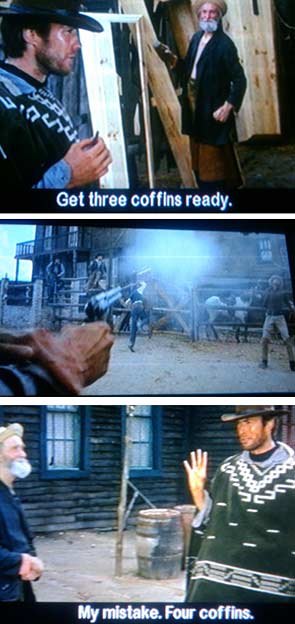
The principle of Occam’s razor suggests that the simplest hypothesis is usually the correct one — or as the character Gil Grissom in “CSI: Crime Scene Investigation” succinctly puts it, if you hear hoofbeats, “think horses, not zebras.”
In his lively new book, “Voodoo Histories,” the journalist David Aaronovitch uses Occam’s razor to eviscerate the many conspiracy theories that have percolated through politics and popular culture over the last century, from those that assert that the 9/11 terrorist attacks were actually a United States government plot to those that claim that Diana, Princess of Wales, was murdered at the direction of the royal family or British intelligence.
In most cases, Mr. Aaronovitch notes, conspiracy theorists would rather tie themselves into complicated knots and postulate all sorts of improbable secret connections than accept a simple, more obvious explanation. (…)
Does the Internet, with its increased democratization of information, help spread conspiracy theories or help expose them? Mr. Aaronovitch says that it was obvious that “sites endorsing 9/11 conspiracy theories and those subscribing to them in passing far outnumbered sites devoted to debunking or refuting such theories.”
He writes that the Internet has enabled the “release of a mass of undifferentiated information, some of it authoritative, some speculative, some absurd,” and that “cyberspace communities of semi-anonymous and occasionally self-invented individuals have grown up, some of them permitting contact between people who in previous times might have thought each other’s interests impossibly exotic and even mad.”
{ NY Times | Continue reading }
books, ideas, scams and heists | February 18th, 2010 5:07 pm







